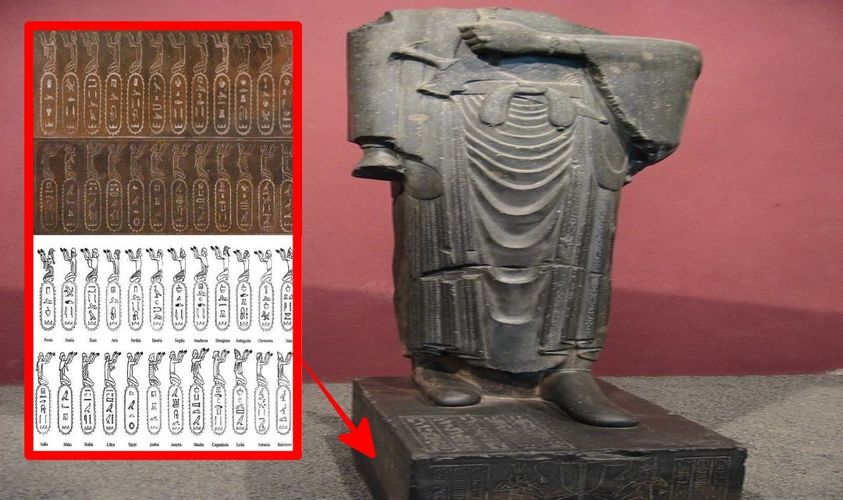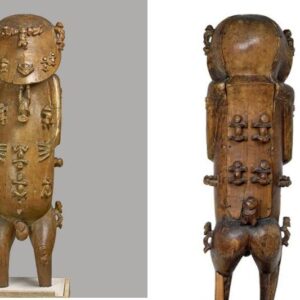The imposing statue of Darius I, an iconic relic from the ancient world, stands as a testament to the grandeur and power of the Achaemenid Empire. Carved from grey granite sourced from the Wadi Hammamat in eastern Egypt, this monumental figure offers a window into the expansive reach of Persian rule during the 5th century BC. Adorned with intricate details and inscriptions, the statue serves as a visual chronicle of the 24 countries subject to the Achaemenid Empire during Darius’s reign.

Each aspect of the statue’s design tells a story, reflecting the political, cultural, and artistic milieu of the time. From the meticulously carved features of Darius himself to the symbolic representations of conquered territories, every element carries layers of meaning waiting to be deciphered by the discerning observer.
The choice of grey granite for the statue’s construction is significant, as chemical analysis has revealed its origins in the Wadi Hammamat of eastern Egypt. This deliberate selection of material underscores the Achaemenid Empire’s ability to command resources from distant lands, highlighting its economic and logistical prowess.
The inscription on the statue provides further insights into its creation and purpose. Scholars believe that the statue was originally commissioned in Egypt and later transported to Susa, possibly during the reign of Xerxes. This suggests a deliberate effort to showcase Darius’s authority and legitimacy as ruler of the Achaemenid Empire, even in territories far removed from the heartland of Persia.
One of the most striking features of the statue is the depiction of the 24 countries subject to the Achaemenid Empire at the time of Darius. These territories, represented symbolically through various means such as inscriptions, motifs, and accompanying figures, offer a glimpse into the vast extent of Persian dominion during this period. From the rich lands of Mesopotamia to the distant reaches of Anatolia and beyond, the Achaemenid Empire’s influence spanned continents, leaving an indelible mark on the ancient world.
The statue’s journey from Egypt to Susa speaks to the interconnectedness of the Achaemenid Empire’s vast territories and the mobility of its rulers and artisans. It also reflects the empire’s cultural exchange and synthesis, as artistic techniques and motifs were shared and adapted across diverse regions and peoples.
As we contemplate the statue of Darius I, we are reminded of the enduring legacy of the Achaemenid Empire and its contributions to the development of human civilization. Through its art, architecture, and imperial ambition, the empire left an indelible mark on history, shaping the course of events for centuries to come. In the statue of Darius I, we find not only a symbol of power and authority but also a testament to the resilience and creativity of the human spirit.
News
The stunning Temple of Garni, Armenia. Built nearly 2,000 years ago.
Nestled amidst the rugged terrain of Armenia stands a testament to ancient splendor: the stunning Temple of Garni. Built nearly 2,000 years ago, this architectural marvel is…
Reviving the Ancient Abu Simbel Temples: Restoration Efforts in Aswan, Egypt, 1968
In 1968, an extraordinary feat of human endeavor unfolded on the banks of the Nile River in Aswan, Egypt. The ancient Abu Simbel temples, standing for over…
Rare and Ancient Sculpture of Lord Ganesha Carved into the Rocks at Raghunandan Hills (Unakoti)
Nestled amidst the rugged terrain of Raghunandan Hills lies a treasure trove of history and spirituality — the rare and ancient sculpture of Lord Ganesha, immortalized in…
African Architecture: The Unique Construction of Djenné’s Great Mosque
In the heart of Mali lies a testament to human ingenuity and cultural heritage: The Great Mosque of Djenné. Built with indigenous materials, primarily mud brick and…
Bronze Spartan Shield from the Battle of Sphacteria 425 BC Displayed at Athenian Agora Museum
Among the many treasures housed at the Athenian Agora Museum, one artifact stands out for its historical significance and the stories it holds: a bronze Spartan shield,…
Enigmatic Pacific Deity: Captivating Polynesian Artistry
In the heart of Polynesia, amidst the whispers of the Pacific winds and the rhythm of ancient chants, lies a testament to the spiritual and artistic richness…
End of content
No more pages to load











